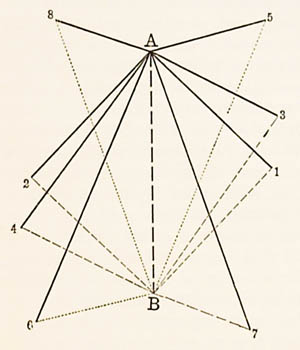

15a. Theodore Eckhardt. Physics in Pictures: The Principal Natural Phenomena and Appliances Described and Illustrated by Thirty Coloured Plates For Ocular Instruction in Schools and Families. (Stanford's Sries of Instructive Picture Books) Translated by A. H. Keane. London: Edward Stanford, 1882.
A style of teaching described as "ocular instruction" is used here to demonstrate the physical principles at work in everyday situations, such as flying a kite.
The plate shown in this exhibition demonstrates two separate scientific concepts: the mysterious "parallelogram of forces" and the densities of bodies. The parallelogram of forces (represented by the diagram to the left) shows that when an object is pulled in two different directions at once it will move in a direction between these two forces. This phenomenon helps explain why a kite can remain airborne. As shown by its tail, it is being blown to the left by the wind and being tugged to the right by its string. It will therefore move straight up. The accompanying text challenges young readers to explain how this same force can be seen to be acting on the boat, the balloon, and the windmill in the picture, a task that would stump many readers today!
